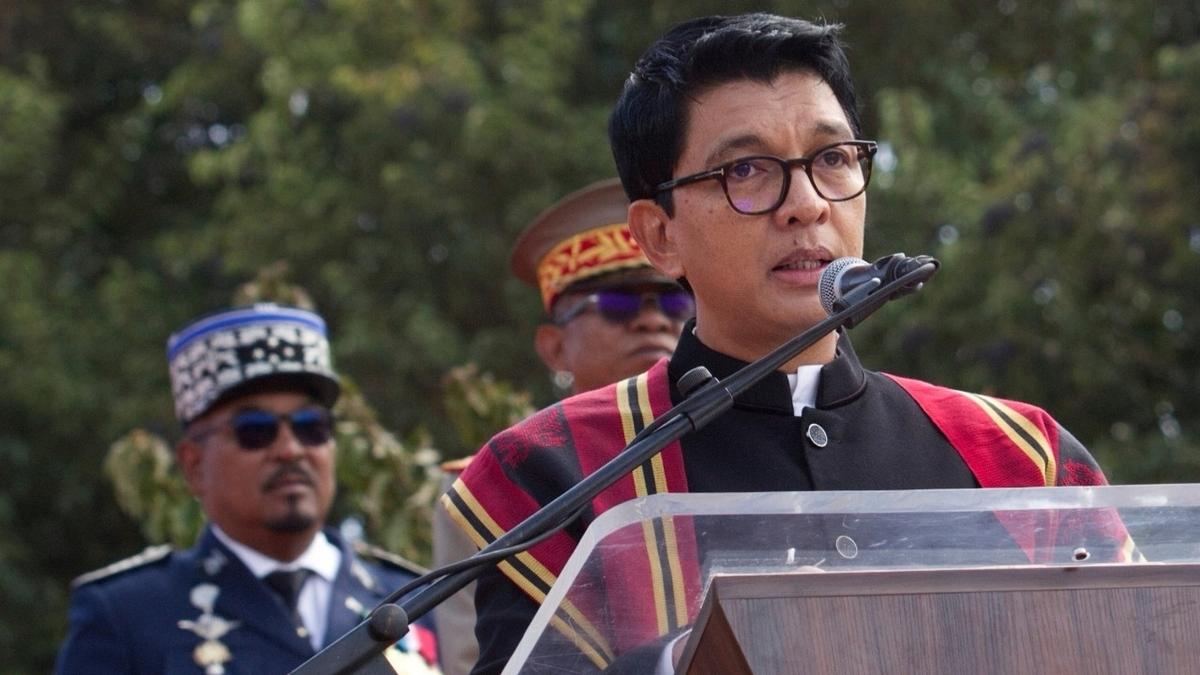- October 14, 2025
Madagascar’s President says he fled the country in fear for his life after military rebellion

Madagascar President Andry Rajoelina said he fled the country in fear for his life following a military rebellion but did not announce his resignation in a speech broadcast on national television late on Monday (October 13, 2025) from an undisclosed location.
Mr. Rajoelina has faced weeks of Gen Z-led anti-government protests, which reached a pivotal point on Saturday when an elite military unit joined the protests and called for the President and other government ministers to step down. That prompted Mr. Rajoelina to say that an illegal attempt to seize power was underway in the Indian Ocean island and to leave the country.
“I was forced to find a safe place to protect my life,” Mr. Rajoelina said in his late-night speech, which was delayed for hours after soldiers attempted to take control of the state broadcaster buildings, the President’s office said.
They were Mr. Rajoelina’s first public comments since the CAPSAT military unit turned against his government in an apparent coup and joined thousands of protesters rallying in a main square in the capital, Antananarivo, over the weekend.
Mr. Rajoelina called for dialogue “to find a way out of this situation” and said the constitution should be respected. He did not say how he left Madagascar or where he was, but a report claimed he was flown out of the country on a French military plane.
A French Foreign Ministry spokesperson declined to comment on that report.
Madagascar is a former French colony, and Mr. Rajoelina reportedly has French citizenship, which has been a source of discontent for some Madagascans for years.
The anti-government protests began on September 25 over chronic water and electricity outages but have snowballed into wider discontent with Rajoelina and his government.
Protesters gesture outside the town hall on Independence Avenue during a nationwide youth-led protest over frequent power outages and water shortages, in Antananarivo, Madagascar.
| Photo Credit:
Reuters
It is the most significant unrest in the island nation of 31 million people off the east coast of Africa since Mr. Rajoelina himself first came to power as the leader of a transitional government following a 2009 military-backed coup.
The same elite CAPSAT military unit that rebelled against Mr. Rajoelina was prominent in his first coming to power in 2009.
Elite unit claims to control the military
Mr. Rajoelina hasn’t identified who was behind this attempted coup, but the CAPSAT unit has said it now controls all the armed forces in Madagascar and has appointed a new officer in charge of the military, which was accepted by the defence minister in Mr. Rajoelina’s absence.
CAPSAT appears to be in a position of authority and also has the backing of other military units, including the gendarmerie security forces.
A commander of CAPSAT, Col. Michael Randrianirina, said the army had “responded to the people’s calls” but denied there was a coup. Speaking at the country’s military headquarters on Sunday, he told reporters that it was up to the Madagascan people to decide what happens next, and if Rajoelina leaves power and a new election is held.
Mr. Randrianirina said his soldiers had decided to stand with protesters and had exchanged gunfire with security forces who were attempting to quell weekend protests, and one of his soldiers was killed. But there was no major fighting on the streets, and soldiers riding on armoured vehicles and waving Madagascar flags were cheered by people in Antananarivo.
The US Embassy in Madagascar still advised American citizens to shelter in place because of a “highly volatile and unpredictable” situation. The African Union urged all parties, “both civilian and military, to exercise calm and restraint.”
Weeks of protests
Madagascar has been shaken by three weeks of deadly anti-government protests that were initially led by a group calling itself “Gen Z Madagascar.”
The United Nations says the demonstrations left at least 22 people dead and dozens injured and criticised Madagascan authorities for a “violent response” to what were largely peaceful protests in the early days of the movement. The government has disputed the number of deaths.
The demonstrators have brought up a range of issues, including poverty and the cost of living, access to tertiary education, and alleged corruption and embezzlement of public funds by government officials, as well as their families and associates.
Civic groups and trade unions also joined the protests, which resulted in nighttime curfews being enforced in Antananarivo and other major cities. Curfews were still in effect in Antananarivo and the northern port city of Antsiranana.
The Gen Z protesters who started the uprising have mobilised over the internet and say they were inspired by the protests that toppled governments in Nepal and Sri Lanka.
History of political crises
Madagascar has had several leaders removed in coups and has a history of political crises since it gained independence from France in 1960.
The 51-year-old Rajoelina first came to prominence as the leader of a transitional government following the 2009 coup that forced then-President Marc Ravalomanana to flee the country and lose power. Mr. Rajoelina was elected President in 2018 and reelected in 2023 in a vote boycotted by opposition parties.
Madagascar’s former Prime Minister under Rajoelina and one of the President’s closest advisers have also fled the country and arrived in the nearby island of Mauritius in the predawn hours Sunday, the Mauritian government said. Mauritius said it was “not satisfied” that the private plane had landed on its territory.
Published – October 14, 2025 04:16 am IST




